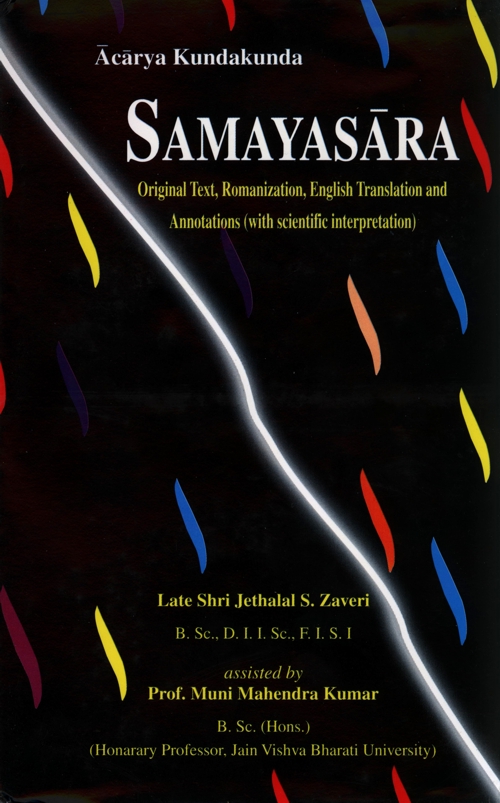
evaṃ vavahārassa du vattavvaṃ daṃsaṇaṃ samāseṇa.
suṇu ṇicchayassa vayaṇaṃ pariṇāmakadaṃ tu ja hodi..46

jaha sippio du cheṭṭhaṃ kuvvadi havadi ya tahā aṇaṇṇo so.
taha jῑvo vi ya kammaṃ kuvvadi havadi ya aṇaṇṇo so..47

jaha ceṭṭhaṃ kuvvaṃto du sippio ṇiccadukkhido hodi.
tatto siyā aṇaṇṇo taha ceṭṭhaṃto duhῑ jῑvo..48
(Evaṃ du vavahārassa daṃsaṇaṃ samāseṇa vattavvaṃ) The following statements briefly describe the doctrine of the soul's modification in accordance with the empirical (vyavahāra) aspect (ṇicchayassa vayaṇaṃ suṇu pariṇāmakadaṃ jaṃ tu hodi) [and, further,] you will hear the doctrine in accordance with the transcendental (niścaya) aspect, which deals with the soul's modification/changes.
(Jaha sippio du) Just as an artisan (such as a goldsmith), (ceṭṭhaṃ kuvvadi) starts his work [of producing earrings etc.] by making a conceptual plan of his work [design of the ornament to be made, method of production and instruments to be used and so on], (tahā ya havadi so aṇaṇṇo) and becomes totally involved and one with the plan, (taha jῑvo vi ya) so also the soul (kammaṃ kuvvadi) first produces suitable psychic tendencies [bhāva karma, such as attachment etc.] (ya so aṇaṇṇo havadi) and becomes one with them.
(Jaha sippio du) Just as an artisan (such as a goldsmith), (ceṭṭhaṃ kuvvaṃto) translates his plan into action (niccadukkhido hodi) [and] becomes miserable with worrying about the work (tatto siyā aṇaṇṇo) [and] becomes one with the worry and misery, (taha jῑvo) so also the soul (ceṭṭhaṃto duhi) suffers and [becomes one with the suffering resulting from] the delights and sorrows of its actions [resulting from the impure psychic dispositions].
Annotations:
In these verses, the author uses the analogy of an artisan or an artist (such as a goldsmith or a painter) to fully explain the non-absolutist views regarding the bondage of karma from both empirical as well as a transcendental aspects. Just as a goldsmith deals with gold as the material from which to produce various types of ornaments, so also the soul has to deal with the karmic matter from which to produce various species of karma. Just as gold is external or non-self vis-a-vis the goldsmith, so is the karmic matter external to the soul. Now a superficial or causal observation of the goldsmith's work reveals that (i) the lump of gold which he is proceeding to shape into an ornament, (ii) the tools and implements which are being used in this process (iii) his talent and dexterity in using the implements to obtain the desired result and (iv) the finished ornament—all remain distinctly different and external facts from the artisan himself.
On the other hand, if one studies the process of creative activity of the goldsmith and tries to interprete his mental states, there appears a different picture of his activity. To start with, every artist or an artisan must form a clear vision of the finished product which he is proceeding to create from the shapeless lump of material—metal or marble. Next, his inner talent and dexterity will control and guide the movements of his hands and tools so as to transfer the mental picture into a physical ornament or work of art. Thus, everything employed by him becomes subservient to the process of transformation and at every stage of the process, one can see the step-by-step progress of the conversion of the mental picture into the work of art. And so from this aspect, the artisan is unified and becomes identical with his creation. And finally, the artisan cannot escape the mental vicissitudes—anxiety, frustration, joy and elation—peculiar to such creative activity of an artisan. The inevitable conclusion is that the goldsmith is neither absolutely different nor absolutely identical with the gold, the tools, the finished ornament and all other auxiliary paraphernalia, mental and physical—used by him in making the ornament.
Much in the same way, the soul like the goldsmith, cannot be identified with the karmic matter, threefold activities, bondage of karma and the hedonic value of the fruits of karma, because all these are external facts and are quite distinct from the nature of the soul. This picture of distinctness corresponds to the superficial and casual observation of the goldsmith's creative activity. On the other hand, from the other aspect, the creative activity of the soul is very much like the inner working of that of the artisan. The soul, in the worldly state of existence, visualizes mental/intellectual pictures of the objects of its desire and proceeds to transform the karmic matter into a pattern of karma which corresponds to the psychic visualization. All the worldly activities become subservient to its feelings and desires, emotions and passions and are transformed in accordance with them. Finally, the soul, like the artisan, cannot escape the experiencing of the hedonic values thereof. From this aspect, then, we have an identical and continuous self-expression and the soul, then, manifests itself, is not entirely different from the process itself. The process, the finished product and the value thereof are but the different stages in the creative activity. Hence, the soul cannot be differentiated from the joys and sufferings which are characteristic of all creative activities. Thus, the two accounts of the artisan's work from two aspects, correspond to the bondage of karma from empirical and transcendental aspects.
 Jethalal S. Zaveri
Jethalal S. Zaveri
 Prof. Muni Mahendra Kumar
Prof. Muni Mahendra Kumar

